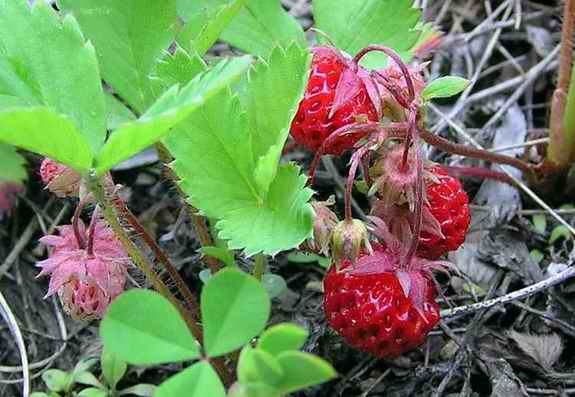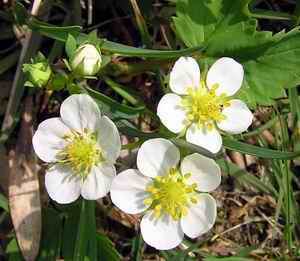|
Common Name: Virginia Strawberry, Indian Strawberry, Scarlet Strawberry, Wild Strawberry, Common Strawberry Scientific Name: Fragaria virginiana (The generic name is from fragum, the Latin word for strawberry, so named because it was fragrant; the species was first identified in the colony of Virginia, hence virginiana). A member of the Rose family.
The name strawberry is subject to a number of etymological hypotheses. One study of plant names appearing in documents in England beginning in the 10th century found successive modifications to the name as "Streowberige, Strea Berige, Streaw Berian Wisan, and StreberWyse" before finally settling on Strawberry in the 15th century. The root word streaw (or streow) is the Anglo-Saxon word for either hay, straw or strew, depending on the source. The "hay" berry theory is that the fruit was called hayberry in 900 CE because it was harvested when the hay was mown. The "straw" berry theory is derived from the practice of covering the ground where the berries were planted with straw to protect them from winter weather. This also lifted the berries off the soil to prevent spoilage and reduce infestation. This theory is supported by the practice of stringing the berries on blades of straw in England and Ireland so that they could be sold in the market as "Straws of Berries." The "strew" berry theory is based on the notion that the fruits were strewn among the leaves and that the runners extended away from the mother plant as if strewn randomly. This also suggests the manner in which the seeds are strewn about on the body of the fruit. Ironically, the strawberry is not a berry at all. It is what is called an accessory fruit.
The strawberry has been known since ancient times as F. vesca, a small fruit of little consequence. The emergence of the large, succulent cultivar (F. ananassa or pineapple strawberry) that became a mainstay of Western culinary culture was the result of a chance union of two New World species of strawberries in the Old World. The domestication of the wild strawberry extends back to Roman times, as it was thought to be a medicinal plant, its roots and leaves used as an astringent to treat diarrhea and its fruits used as means to brighten the teeth. By the 14th century, it was in cultivation in Europe.
When the New World was discovered F. virginiana was found in "vast patches � along the great river and in the woods" according to French explorer Jacques Cartier in 1534. Roger Williams, founder of Rhode Island, noted that "the Indians bruised them in a mortar, and mixe them with meale and make strawberry bread." The colonists took note and developed their own recipe which is the supposed origin of strawberry shortcake. The settlers began cultivation of the Virginia strawberry, and sent seeds back to the Old Country. However, the plants did not fruit well, as it was not known at that time that the strawberry is dioecious; male pollen from a male plant must be adjacent to a female plant in order for successful pollination.
In 1714, Lieutenant Colonel Amedee Francois Frezier was dispatched by King Louis XIV of France to spy on the Spanish in South America. During his surreptitious inspections of the Chilean fortifications, he noted an unusually large strawberry growing in the wild. The Spaniards called it "fruitilla" meaning little fruit. As an amateur botanist, Frezier brought five plants that were later officially named F. chiloensis (from Chile) back to France with him when he returned. He gave one to the King's gardener and distributed the four others to gardens around his home in Brest. Like their cousins from Virginia, the fruitillas seldom produced fruit, and certainly not of the size that had been found in Chile. This was because they too are dioecious. By 1740, chance plantings of F. chiloensis with F. virginiana produced the self-fertilizing hybrid we know as F. ananassa. The explanation of the reason for successful fertilization was not provided until 1766 by the French botanist Antoine Nicolas Duchesne |

 The
strawberry flower cluster is a series of branches that bear a flower in the
crotch of each branch, the first branch having the largest, or primary flower,
the next two crotches bear the secondary flowers and so on to as many as 16
quinary flowers. The primary flower produces the largest fruit, which is an
aggregate of achenes. The achenes are the true fruits of the strawberry, each
having a style, a stigma and an ovule. They are embedded in a receptacle that
accumulates vitamins and sugars and looks and tastes like a fruit. It is
called an accessory fruit because it has the additional structure to support
the seeds. In spite of the complicated and extensive system of multiple
achenes (one researcher reported 518 seeds on one large strawberry), the
strawberry normally reproduces with rooted runners and not seeds.
The
strawberry flower cluster is a series of branches that bear a flower in the
crotch of each branch, the first branch having the largest, or primary flower,
the next two crotches bear the secondary flowers and so on to as many as 16
quinary flowers. The primary flower produces the largest fruit, which is an
aggregate of achenes. The achenes are the true fruits of the strawberry, each
having a style, a stigma and an ovule. They are embedded in a receptacle that
accumulates vitamins and sugars and looks and tastes like a fruit. It is
called an accessory fruit because it has the additional structure to support
the seeds. In spite of the complicated and extensive system of multiple
achenes (one researcher reported 518 seeds on one large strawberry), the
strawberry normally reproduces with rooted runners and not seeds.